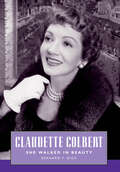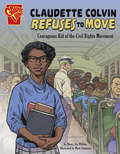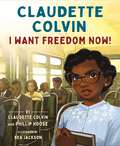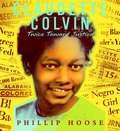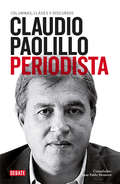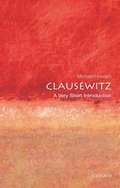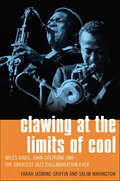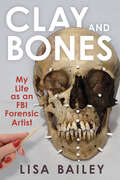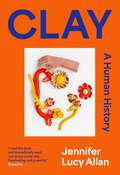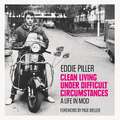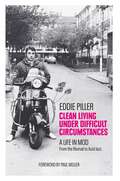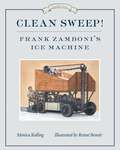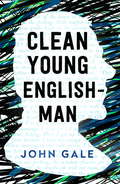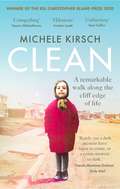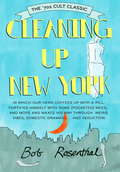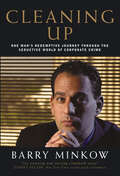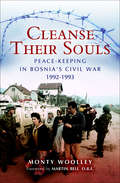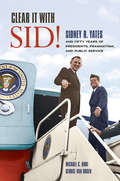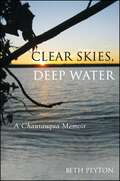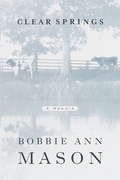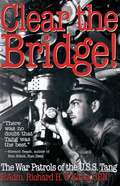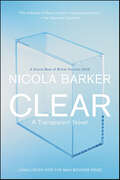- Table View
- List View
Claudette Colbert: She Walked in Beauty (Hollywood Legends Series)
by Bernard F. DickClaudette Colbert's mixture of beauty, sophistication, wit, and vivacity quickly made her one of the film industry's most famous and highest-paid stars of the 1930s and 1940s. Though she began her career on the New York stage, she was beloved for her roles in such films as Preston Sturges's The Palm Beach Story, Cecil B. DeMille's Cleopatra, and Frank Capra's It Happened One Night, for which she won an Academy Award. She showed remarkable prescience by becoming one of the first Hollywood stars to embrace television, and she also returned to Broadway in her later career. This is the first major biography of Colbert (1903–1996) published in over twenty years. Bernard F. Dick chronicles Colbert's long career, but also explores her early life in Paris and New York. Along with discussing how she left her mark on Broadway, Hollywood, radio, and television, the book explores Colbert's lifelong interests in painting, fashion design, and commercial art. Using correspondence, interviews, periodicals, film archives, and other research materials, the biography reveals a smart, talented actress who conquered Hollywood and remains one of America's most captivating screen icons.
Claudette Colvin Refuses to Move: Courageous Kid of the Civil Rights Movement (Courageous Kids)
by Ebony Joy WilkinsIt's March 2, 1955, and an ordinary 15-year-old girl from Montgomery, Alabama is about to do something extraordinary. When a white bus driver orders Claudette Colvin to give up her seat for a white passenger, she refuses to move. After Claudette is arrested, her brave actions help inspire Civil Rights leaders organize bus boycotts and perform similar acts to defy segregation laws. Eventually, Claudette's court case results in overturning Alabama's unconstitutional laws and provides greater freedom for black Americans everywhere.
Claudette Colvin: I Want Freedom Now!
by Phillip Hoose Claudette ColvinCivil rights icon Claudette Colvin teams up with Phillip Hoose—author of the Newbery Honor and National Book Award-winning blockbuster biography Claudette Colvin: Twice Toward Justice—to tell her groundbreaking story in this unforgettable picture book illustrated by New York Times–bestselling artist Bea Jackson.Montgomery, Alabama 1955. Fifteen-year-old Claudette Colvin is tired. Tired of white people thinking they’re better than her. Tired of going to separate schools and separate bathrooms. Most of all, she’s tired of having to give up her seat on the bus whenever a white person tells her to. She wants freedom NOW! But what can one teenager do?On a bus ride home from school one day, young Claudette takes a stand for justice and refuses to get up from her seat—nine months before Rosa Parks will become famous for doing the same. What follows will not only transform Claudette’s life but the course of history itself.In the words of Claudette Colvin herself, as told to acclaimed nonfiction writer Phillip Hoose, this empowering, heroic story illustrates how one simple act of courage can create real and lasting change.
Claudette Colvin: Twice Toward Justice
by Phillip M. Hoose"When it comes to justice, there is no easy way to get it. You can't sugarcoat it. You have to take a stand and say, 'This is not right.'" - Claudette Colvin<P><P> On March 2, 1955, an impassioned teenager, fed up with the daily injustices of Jim Crow segregation, refused to give her seat to a white woman on a segregated bus in Montgomery, Alabama. Instead of being celebrated as Rosa Parks would be just nine months later, fifteen-year-old Claudette Colvin found herself shunned by her classmates and dismissed by community leaders. Undaunted, a year later she dared to challenge segregation again as a key plaintiff in Browder v. Gayle, the landmark case that struck down the segregation laws of Montgomery and swept away the legal underpinnings of the Jim Crow South. Based on extensive interviews with Claudette Colvin and many others, Phillip Hoose presents the first in-depth account of an important yet largely unknown civil rights figure, skillfully weaving her dramatic story into the fabric of the historic Montgomery bus boycott and court case that would change the course of American history.<P> Claudette Colvin is the 2009 National Book Award Winner for Young People's Literature, a 2010 Newbery Honor Book, a Sibert Honor book, and a Jane Addams Honor book.
Claudio Paolillo. Periodista: Columnas, clases y discursos
by Claudio PaolilloEste libro es el legado profesional de uno de los periodistas más importantes del último medio siglo en Uruguay. Los textos escogidos, varios de ellos inéditos, son el resultado de una selección de más de cuarenta años de periodismo donde todos los jueves Paolillo se convirtió en un analista de la actualidad referente en el país. Claudio Paolillo ha sido uno de los periodistas más influyentes en Uruguay desde el retorno de la democracia. Sus columnas en Búsqueda atraparon lectores, inquietaron gobernantes y marcaron agenda. Sus discursos en defensa de la libertad en los foros más encumbrados del continente demostraron su valentía y liderazgo. Sus clases de periodismo, en la redacción y en las aulas, siempre apasionadas y profundas, calaron hondo en generaciones de periodistas. Este libro, que incluye material inédito, reúne muchos de sus trabajos más emblemáticos para lograr ilustrar el pensamiento de un profesional admirado en toda América. Claudio Paolillo. Periodista es un libro de una vigencia impactante, que explica el rol del periodismo contemporáneo y resulta una lectura esencial para entender la sociedad, la política y la cultura del Uruguay. Es también un homenaje a su trayectoria, una invitación a pensar con libertad y una fuente de inspiración para el futuro.
Clausewitz: A Very Short Introduction
by Michael HowardKarl von Clausewitz (1780-1831) is considered by many to have been one of the greatest writers on war. His study On War was described by the American strategic thinker Bernard Brodie as "not simply the greatest, but the only great book about war." It is hard to disagree. Even though he wrote his only major work at a time when the range of firearms was fifty yards, much of what he had to say remains relevant today. Michael Howard explains Clausewitz's ideas in terms both of his experiences as a professional soldier in the Napoleonic Wars, and of the intellectual background of his time.
Clawing at the Limits of Cool: Miles Davis, John Coltrane and the Greatest Jazz Collaboration Ever
by Farah Jasmine Griffin Salim WashingtonWhen the renowned trumpeter and bandleader Miles Davis chose the members of his quintet in 1955, he passed over well-known, respected saxophonists such as Sonny Rollins to pick out the young, still untested John Coltrane. What might have seemed like a minor decision at the time would instead set the course not just for each of their careers but for jazz itself. Clawing at the Limits of Cool is the first book to focus on Davis and Coltrane's musical interaction and its historical context, on the ways they influenced each other and the tremendous impact they've had on culture since then. It chronicles the drama of their collaboration, from their initial historic partnership to the interlude of their breakup, during which each man made tremendous progress toward his personal artistic goals. And it continues with the last leg of their journey together, a time when the Miles Davis group, featuring John Coltrane, forever changed the landscape of jazz. Authors Farah Jasmine Griffin and Salim Washington examine the profound implications that the Davis/Coltrane collaboration would have for jazz and African American culture, drawing parallels to the changing standards of African American identity with their public personas and private difficulties. With vastly different personal and musical styles, the two men could not have been more different. One exemplified the tough, closemouthed cool of the fifties while the other made the transition during this time from unfocused junkie to a religious pilgrim who would inspire others to pursue spiritual enlightenment in the coming decade. Their years together mark a watershed moment, and Clawing at the Limits of Cool draws on both cultural history and precise musical detail to illuminate the importance that their collaboration would have for jazz and American history as a whole.
Clay and Bones: My Life as an FBI Forensic Artist
by Lisa G. BaileyTold with unflinching honesty and a touch of gallows humor,Clay and Bonesis the personal memoir of the first female forensic sculptor in the FBI. Lisa Bailey never considered a career working in death until she saw the FBI job posting for a forensic artist. The idea of using her artistic skill to help victims of crime was too compelling to pass up. Soon she was documenting crime scenes, photographing charred corpses, and digitally retouching the disembodied heads of suicide bombers. But it was facial approximation—sculpting a face from the remnants of an unidentified victim's skull—that intrigued her the most. Bailey knew that if she could capture that person's likeness in clay, she just might help them be identified, and that might help law enforcement track down their killer. Bailey worked on hundreds of cases and grew to become a subject matter expert in the field. It was the most challenging and fulfilling work she could have imagined, and she never thought of leaving. But her life changed when she became the target of sexual discrimination and harassment. She was stunned when FBI management protected the abusers and retaliated with threats, slander, and an arsenal of lawyers. Trapped in an increasingly hostile work environment, and infuriated at the hypocrisy of the FBI's tactics, Bailey decided to fight back.Clay and Bones is a memoir with a mission, and a fascinating exploration into the surreal and satisfying work of a forensic artist.
Clay: A Human History
by Jennifer Lucy Allan'Clay contains infinite possibilities in its transmutations, evidenced on the shelves of our homes, our galleries and museums. Every time we make something with clay, we engage with the timelines that are in the material itself, whether it was dug from a clifftop, riverbed or pit. In firing what we make, we bestow the material with function, meaning, or feeling, and anchor its form in a human present... Objects made from clay contain marks of our existence that collectively tell the story of human history more completely than any other material. There is a reason there are so many pots in museums: because fired clay is one of the most effective keepers of stories we have.'This book is a love letter to clay, the material that is at the beginning, middle and end of all of our lives; that contains within it the eternal, the elemental, and the everyday.People have been taking handfuls of earth and forming them into their own image since human history began. Human forms are found everywhere there was a ceramic tradition, and there is a ceramic tradition everywhere there was human activity. The clay these figures are made from was formed in deep geological time. It is the material that God, cast as the potter, uses to form Adam in Genesis. Tomb paintings in Egypt show the god Khnum at a potter's wheel, throwing a human. Humans first recorded our own history on clay tablets, the shape of the characters influenced by the clay itself. The first love poem was inscribed in a clay tablet, from a Sumerian bride to her king more than 4000 years ago. Born out of a desire to know and understand the mysteries of this material, the spiritual and practical applications of clay in both its micro and macro histories, Clay: A Human History is a book of wonder and insight, a hybrid of archaeology, history and lived experience as an amateur potter.
Clay: A Human History
by Jennifer Lucy Allan'Clay contains infinite possibilities in its transmutations, evidenced on the shelves of our homes, our galleries and museums. Every time we make something with clay, we engage with the timelines that are in the material itself, whether it was dug from a clifftop, riverbed or pit. In firing what we make, we bestow the material with function, meaning, or feeling, and anchor its form in a human present... Objects made from clay contain marks of our existence that collectively tell the story of human history more completely than any other material. There is a reason there are so many pots in museums: because fired clay is one of the most effective keepers of stories we have.'This book is a love letter to clay, the material that is at the beginning, middle and end of all of our lives; that contains within it the eternal, the elemental, and the everyday.People have been taking handfuls of earth and forming them into their own image since human history began. Human forms are found everywhere there was a ceramic tradition, and there is a ceramic tradition everywhere there was human activity. The clay these figures are made from was formed in deep geological time. It is the material that God, cast as the potter, uses to form Adam in Genesis. Tomb paintings in Egypt show the god Khnum at a potter's wheel, throwing a human. Humans first recorded our own history on clay tablets, the shape of the characters influenced by the clay itself. The first love poem was inscribed in a clay tablet, from a Sumerian bride to her king more than 4000 years ago. Born out of a desire to know and understand the mysteries of this material, the spiritual and practical applications of clay in both its micro and macro histories, Clay: A Human History is a book of wonder and insight, a hybrid of archaeology, history and lived experience as an amateur potter.
Clean Living Under Difficult Circumstances: A Life In Mod – From the Revival to Acid Jazz
by Eddie Piller***'Eddie was there very early doors. His story is of the many.' Paul Weller'A total riot! Takes me right back to the 70s. A Superb book' Mani, The Stone Roses'What a wonderful book. Mod isn't about what decade you lived in, it's about your attitude, and this book has tons of it' Kenney Jones, The Small Faces'A charismatic storyteller, witty and unpretentious, he is at once an engaging protagonist and an indisputable authority, giving a live-wire, visceral perspective on mod life in that short flash of time. He manages to create a welcoming space in this rather exclusive world while never losing his formidable edge as a narrator' - The Big Issue'Buy it on sight. You won't be disappointed' - Louder Than War'Eddie's book is really good!' - Robert Elms'Akin to being in the company of someone with plenty of entertaining tales to tell.... the comradery and spirit of like-minded souls is inspiring.' - Paul Ritchie, Shindig! MagazineWITH A FOREWORD BY PAUL WELLERThis is the memoir of a teenage mod from the East End of London.A journey of discovery for a schoolboy dabbling with punk, funk, record shops, discos and clothes, and then... WHAAAM! An unstoppable wave of like-minded kids fall headlong in love with 60s mod culture, revived and reformatted for the 70s and 80s generation.Eddie Piller was one such kid. His life was changed forever. Written with humour, passion and attention to detail, CLEAN LIVING UNDER DIFFICULT CIRCUMSTANCES is perhaps the ultimate mod memoir, taking us from meeting the Small Faces as a toddler, to the 1979 Mod revival, through the more purist 1980s mod scene and eventually to Acid Jazz.A born storyteller, Eddie takes us evocatively into a world of scooters, clothes, and music. We run with the crowd to decaying seaside towns, East End backstreet boozers and sweaty teenage gigs, all fizzing with an uncontainable excitement and often exploding into violence.Once mod touched your soul it changed the way you looked at life, unexpectedly broadening your horizons. In Eddie it awakens a can-do attitude that sees him setting up a fanzine, putting on club nights, hustling jobs in the music industry, and eventually setting up a record label. It even takes him to Ireland at the height of the troubles and to Australia where the local mods take him on a military exercise...Visceral and always entertaining, CLEAN LIVING UNDER DIFFICULT CIRCUMSTANCES is a stand-out memoir that relives the thrill of the 70s and 80s, and the movement that helped make mod the most enduring and successful British youth culture of all time.
Clean Living Under Difficult Circumstances: A Life In Mod – From the Revival to Acid Jazz
by Eddie Piller***'Eddie was there very early doors. His story is of the many.' Paul Weller'A total riot! Takes me right back to the 70s. A Superb book' Mani, The Stone Roses'What a wonderful book. Mod isn't about what decade you lived in, it's about your attitude, and this book has tons of it' Kenney Jones, The Small Faces'A charismatic storyteller, witty and unpretentious, he is at once an engaging protagonist and an indisputable authority, giving a live-wire, visceral perspective on mod life in that short flash of time. He manages to create a welcoming space in this rather exclusive world while never losing his formidable edge as a narrator' - The Big Issue'Buy it on sight. You won't be disappointed' - Louder Than War'Eddie's book is really good!' - Robert Elms'Akin to being in the company of someone with plenty of entertaining tales to tell.... the comradery and spirit of like-minded souls is inspiring.' - Paul Ritchie, Shindig! MagazineWITH A FOREWORD BY PAUL WELLERThis is the memoir of a teenage mod from the East End of London.A journey of discovery for a schoolboy dabbling with punk, funk, record shops, discos and clothes, and then... WHAAAM! An unstoppable wave of like-minded kids fall headlong in love with 60s mod culture, revived and reformatted for the 70s and 80s generation.Eddie Piller was one such kid. His life was changed forever. Written with humour, passion and attention to detail, CLEAN LIVING UNDER DIFFICULT CIRCUMSTANCES is perhaps the ultimate mod memoir, taking us from meeting the Small Faces as a toddler, to the 1979 Mod revival, through the more purist 1980s mod scene and eventually to Acid Jazz.A born storyteller, Eddie takes us evocatively into a world of scooters, clothes, and music. We run with the crowd to decaying seaside towns, East End backstreet boozers and sweaty teenage gigs, all fizzing with an uncontainable excitement and often exploding into violence.Once mod touched your soul it changed the way you looked at life, unexpectedly broadening your horizons. In Eddie it awakens a can-do attitude that sees him setting up a fanzine, putting on club nights, hustling jobs in the music industry, and eventually setting up a record label. It even takes him to Ireland at the height of the troubles and to Australia where the local mods take him on a military exercise...Visceral and always entertaining, CLEAN LIVING UNDER DIFFICULT CIRCUMSTANCES is a stand-out memoir that relives the thrill of the 70s and 80s, and the movement that helped make mod the most enduring and successful British youth culture of all time.
Clean Living Under Difficult Circumstances: A Life In Mod – From the Revival to Acid Jazz
by Eddie Piller***'Eddie was there very early doors. His story is of the many.' Paul Weller'A total riot! Takes me right back to the 70s. A Superb book' Mani, The Stone Roses'What a wonderful book. Mod isn't about what decade you lived in, it's about your attitude, and this book has tons of it' Kenney Jones, The Small Faces'A charismatic storyteller, witty and unpretentious, he is at once an engaging protagonist and an indisputable authority, giving a live-wire, visceral perspective on mod life in that short flash of time. He manages to create a welcoming space in this rather exclusive world while never losing his formidable edge as a narrator' - The Big Issue'Buy it on sight. You won't be disappointed' - Louder Than War'Eddie's book is really good!' - Robert Elms'Akin to being in the company of someone with plenty of entertaining tales to tell.... the comradery and spirit of like-minded souls is inspiring.' - Paul Ritchie, Shindig! MagazineWITH A FOREWORD BY PAUL WELLERThis is the memoir of a teenage mod from the East End of London.A journey of discovery for a schoolboy dabbling with punk, funk, record shops, discos and clothes, and then... WHAAAM! An unstoppable wave of like-minded kids fall headlong in love with 60s mod culture, revived and reformatted for the 70s and 80s generation.Eddie Piller was one such kid. His life was changed forever. Written with humour, passion and attention to detail, CLEAN LIVING UNDER DIFFICULT CIRCUMSTANCES is perhaps the ultimate mod memoir, taking us from meeting the Small Faces as a toddler, to the 1979 Mod revival, through the more purist 1980s mod scene and eventually to Acid Jazz.A born storyteller, Eddie takes us evocatively into a world of scooters, clothes, and music. We run with the crowd to decaying seaside towns, East End backstreet boozers and sweaty teenage gigs, all fizzing with an uncontainable excitement and often exploding into violence.Once mod touched your soul it changed the way you looked at life, unexpectedly broadening your horizons. In Eddie it awakens a can-do attitude that sees him setting up a fanzine, putting on club nights, hustling jobs in the music industry, and eventually setting up a record label. It even takes him to Ireland at the height of the troubles and to Australia where the local mods take him on a military exercise...Visceral and always entertaining, CLEAN LIVING UNDER DIFFICULT CIRCUMSTANCES is a stand-out memoir that relives the thrill of the 70s and 80s, and the movement that helped make mod the most enduring and successful British youth culture of all time.
Clean Sweep! Frank Zamboni's Ice Machine: Great Idea Series (Great Idea Series #8)
by Monica KullingWhen Frank Zamboni, along with his brother and cousin, opened their own skating rink in 1940 in Paramount, California, it could take an hour and a half for a crew to resurface the ice. They had to level the surface by shaving down the pits and grooves with a tractor, remove the shavings, wash the ice and find a way to give the rink its shining finish. Skaters became exasperated with the wait, so Frank was determined to do something about it. Could he turn a ninety-minute job for five men into a ten-minute task for only one? Working in the shed behind his ice rink, Frank drew designs and built models of machines he hoped would do the job. For nine years, he worked on his invention, each model an improvement on the one before. Finally, in 1949, Frank tested the Model A, which "cleaned the ice in one sweep around the rink." The rest is history.
Clean Young Englishman
by John GaleFirst published in 1965 John Gale's autobiography is one the brilliant evocations of English life. From growing up in rural Kent to joining the Coldstream Guards and drunkenly dancing with the young Princess Elizabeth at Windsor Castle, Gale's early years seemed untroubled by darker shadows. But later, as a foreign correspondent in Algeria, Egypt and the Far East, he witnessed scenes of such horror that his comfortable world - and his sanity - were shaken to their very foundations. Witty, ironic, sharply observed and deeply moving, John Gale's memoir is a unique record of a young man struggling to make sense of the world.
Clean: A remarkable walk along the cliff edge of life *2020 winner of the Christopher Bland Prize*
by Michele Kirsch***2020 winner of the Christopher Bland Prize***"Beautifully crafted and written, filled with darkness and light, compelling... She fights addiction with honesty and humour. And, like her, [we] come away changed forever." Yasmin Alibhai-Brown, RSL Christopher Bland PrizeWhen Michele Kirsch's father is killed in a train crash, her mother gets the vapours and Michele gets extremely nervous. By her mid-teens, she has found salvation in valium. Her favourite words on the prescription sheet are "Take As Needed", which she interprets as Take All The Time.Later, as a wife and mother, she adds alcohol into the mix, and before long her life is spinning out of control. Leaving home "for the sake of the family", she takes the scenic route to rehab, redemption and reinvention.But this is no misery memoir. Clean is a darkly comic tale about the difficult choices we have to make as we navigate our lives. While working as a domestic cleaner in her 50s, Michele finds herself living vicariously through other people's messes, tidying her way through early sobriety. As the Duster of Large Things, she taps into her natural nosiness to reveal the absurdities of a seemingly banal job.
Clean: A remarkable walk along the cliff edge of life *2020 winner of the Christopher Bland Prize*
by Michele Kirsch***2020 winner of the Christopher Bland Prize***"Beautifully crafted and written, filled with darkness and light, compelling... She fights addiction with honesty and humour. And, like her, [we] come away changed forever." Yasmin Alibhai-Brown, RSL Christopher Bland PrizeWhen Michele Kirsch's father is killed in a train crash, her mother gets the vapours and Michele gets extremely nervous. By her mid-teens, she has found salvation in valium. Her favourite words on the prescription sheet are "Take As Needed", which she interprets as Take All The Time.Later, as a wife and mother, she adds alcohol into the mix, and before long her life is spinning out of control. Leaving home "for the sake of the family", she takes the scenic route to rehab, redemption and reinvention.But this is no misery memoir. Clean is a darkly comic tale about the difficult choices we have to make as we navigate our lives. While working as a domestic cleaner in her 50s, Michele finds herself living vicariously through other people's messes, tidying her way through early sobriety. As the Duster of Large Things, she taps into her natural nosiness to reveal the absurdities of a seemingly banal job.
Cleaning Up New York
by Bob RosenthalTHE EAST VILLAGE, NYC, 1976.A 26-year-old starving poet needs $60. What else to do but register with a temp agency as a house cleaner? The excitement never wanes as he is catapulted into the everyday yet unimaginable worlds behind closed (apartment) doors. Bob knows one thing: the dirt will always win. Clients are a bit more unpredictable, he discovers, as he comes to terms with eccentric domestic habits and strange discoveries. When Bob becomes a weekly fixture in his clients' lives, anything can happen, and does, including a memorable encounter with an obliging Hoover that ultimately proves unable to get the job done. Cleaning Up New York has been a cult classic since it was first published in 1976 in an edition of 750.
Cleaning Up: One Man's Redemptive Journey Through the Seductive World of Corporate Crime
by Barry MinkowAfter being convicted and sent to federal prison for a white-collar crime, a man finds faith and starts over as a pastor and fraud investigator.Before he was even old enough to drink, he had bank accounts, a Ferrari, a mansion, a multi-million dollar corporation, and a desperate little secret . . . it was all a lie. Most of us can’t imagine life getting much worse than it got for Barry Minkow, the one-time Wall Street whiz kid who catapulted his company to stardom and success only to see it exposed as a $300-million fraud. Most of us can’t imagine spending more than seven years in federal prison and coming out owing victims $26 million. Most of us can’t imagine our careers changing from FBI target to FBI trainer, from CEO to senior pastor, from con man to con catcher. Or can we? We’ve all slipped up. We’ve all failed. Cleaning Up is Barry Minkow’s comeback story-a powerful a tale of redemption and inspiration, of second chances and setting things right. More than a decade from defrauding investors, today, as cofounder of the Fraud Discovery Institute, he’s uncovered over a billion dollars worth of investment scams.
Cleanse Their Souls: Peace-Keeping in Bosnia's Civil War, 1992–1993
by Monty WoolleyA memoir of the lethal conflict in the former Yugoslavia, by a British soldier who was on the front lines. This is a young cavalry lieutenant&’s moving and shocking account of front line service in the cauldron of war. His troop of Scimitar light-armored vehicles was attached to the 1 CHESHIRE Battle Group, under the charismatic command of Colonel Bob Stewart. Fresh from Germany, he and his men found themselves in a highly political and lethally dangerous civil war. They witnessed appalling atrocities and human tragedy on a giant scale. Yet both soldiers and civilians showed massive courage and resilience. Thanks to the author's diary, we have here an extraordinary, spontaneous, and important account of British troops performing vital military and humanitarian tasks, described by war correspondent and MP Martin Bell as &“earning its place among the impartial narratives of the Bosnian War.&”
Clear It with Sid!: Sidney R. Yates and Fifty Years of Presidents, Pragmatism, and Public Service
by Michael Dorf George Van DusenThe son of a Lithuanian blacksmith, Sidney R. Yates rose to the pinnacle of Washington power and influence. As chair of a House Appropriations Subcommittee, Yates was a preeminent national figure involved in issues that ranged from the environment and Native American rights to Israel and support for the arts. Speaker Tip O'Neill relied on the savvy Chicagoan in the trenches and advised anyone with controversial legislation to first "clear it with Sid!" Michael C. Dorf and George Van Dusen draw on scores of interviews and unprecedented access to private papers to illuminate the life of an Illinois political icon. Wise, energetic, charismatic, petty, stubborn--Sid Yates presented a complicated character to constituents and colleagues alike. Yet his get-it-done approach to legislation allowed him to bridge partisan divides in the often-polarized House of Representatives. Following Yates from the campaign trail to the negotiating table to the House floor, Dorf and Van Dusen offer a rich portrait of a dealmaker extraordinaire and tireless patriot on a fifty-year journey through postwar American politics.
Clear Skies, Deep Water: A Chautauqua Memoir (Excelsior Editions)
by Beth PeytonAfter a year of devastating personal and financial loss, Beth Peyton and her husband, Jeff, moved to the hamlet of Maple Springs, New York, on Chautauqua Lake to pick up the pieces of their lives, certain to be in a place that they loved and certain of nothing else. As they worked to restore a neglected old house, the community, the beauty of the lake, and the old-fashioned sensibility of the place comforted them. While Peyton's story traces the couple's progress toward recovery, it also includes tales of the silly, colorful, and warm characters who became their neighbors and friends. Whether it's the mystery of Emil and Betty's lost blue plate, dead bodies in the water, or memories of karaoke at the Village Casino, Clear Skies, Deep Water is a testament to the healing power of rituals, friendships, the beauty of the natural world, and the possibility of grace. Filled with nostalgia about an America that has slipped, or is slipping away, it will resonate with anyone who has searched for meaning and home.
Clear Springs
by Bobbie Ann Mason<P>In this superb memoir, the bestselling author of In Country and other award-winning books tells her own story, and the story of a Kentucky farm family, the Masons of Clear Springs. <P> Like Russell Baker's Growing Up, Jill Ker Conway's The Road from Coorain, and other classic literary memoirs, Clear Springs takes us back in time to recapture a way of life that has all but disappeared, a country culture deeply rooted in work and food and family, in common sense and music and the land. <P>Clear Springs is also an American woman's odyssey, exploring how a misfit girl who dreamed of distant places grew up in the forties, fifties, and sixties, and fulfilled her ambition to be a writer. <P> A multilayered narrative of three generations--Bobbie Ann Mason, her parents and grandparents--Clear Springs gracefully interlaces several different lives, decades, and locales, moving from the industrious life on a Kentucky farm to travels around the South with Mason as president of the Hilltoppers Fan Club; from the hippie lifestyle of the 1960s New York counterculture to the shock-therapy ward of a mental institution; from a farmhouse to the set of a Hollywood movie; from pop music concerts to a small rustic schoolhouse. <P>Clear Springs depicts the changes that have come to family, to women, and to heartland America in the twentieth century, as well as to Bobbie Ann Mason herself. <P>When the movie of Mason's bestselling novel In Country is filmed near Clear Springs, it brings the first limousines to town, even as it brings out once again the wisdom and values of Mason's remarkable parents. <P>Her mother, especially, stands at the center of this book. Mason's journey leads her to a recognition of the drama and significance of her mother's life and to a new understanding of heritage, place, and family roots. <P> Brilliant and evocative, Clear Springs is a stunning achievement.
Clear the Bridge!: The War Patrols of the U.S.S. Tang
by Richard O'KaneTang carried the war to the enemy with unparalleled ferocity. This is her story as told by her skipper.From the Trade Paperback edition.
Clear: A Transparent Novel
by Nicola BarkerOn September 5, 2003, illusionist David Blaine entered a small Perspex box adjacent to London's Thames River and began starving himself. Forty-four days later, on October 19, he left the box, fifty pounds lighter. That much, at least, is clear. And the rest? The crowds? The chaos? The hype? The rage? The fights? The lust? The filth? The bullshit? The hypocrisy?Nicola Barker fearlessly crams all that and more into this ribald and outrageous peep show of a novel, her most irreverent, caustic, up-to-the-minute work yet, laying bare the heart of our contemporary world, a world of illusion, delusion, celebrity, and hunger.
